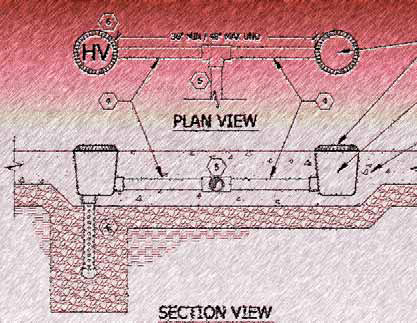Pools & Spas
Sometimes, the main idea that will drive a design jumps to mind as soon as you see the site. That was the case with the project covered here: When I pulled up to the gate of the property - high in the affluent hills of Bel Air, Calif. - what I found wasn't a big, showy home of the sort that have increasingly come to characterize the neighborhood; instead, what I saw was a place defined by subtlety and elegance. It all started with the gate's beautiful brick pilaster, beyond which I could just glimpse a large, lovely home with the distinctive architecture of an English manor house. Even though I hadn't met the clients yet or seen the entire job site, I was already convinced that the project would be
Unlike most companies that become deeply involved in exterior environments, we at D'Asign Source of Marathon, Fla., are also happy to get involved in designing and building everything else associated with a given property. When asked by our clients to do so, we tackle it all, from designing and engineering a home and taking care of all the licensing and construction, to furnishing the interiors and providing luxurious details inside and out. And when we're done, we'll happily service
Unlike most companies that become deeply involved in exterior environments, we at D'Asign Source of Marathon, Fla., are also happy to get involved in designing and building everything else associated with a given property. When asked by our clients to do so, we tackle it all, from designing and engineering a home and taking care of all the licensing and construction, to furnishing the interiors and providing luxurious details inside and out. And when we're done, we'll happily service
The death in 2002 of the granddaughter of former U.S. Secretary of State James Baker brought the problem of suction entrapment to unprecedented public attention. That incident - and others in which bathers have become stuck atop pool drains - have led to development of new legislation and pool-construction standards as well as increased awareness of the hazard. To me and some others, however, the new rules represent a reactive, regulatory solution to what might better be approached as a proactive matter of technology and engineering. In stepping back and carefully examining the anatomy of these terrible accidents, it becomes clear that, although steps can be taken to reduce risks, there is no single approach, given current design and construction practices, that will eliminate risks altogether. So far, in fact, all of the industry education and media attention we've witnessed is focused on solutions that at best mitigate entrapment hazards but do not eliminate them. These are not, unfortunately, approaches that lead us to complete and effective solutions. As an industry, we have not grappled with what I see as the true, addressable core of the issue
The death in 2002 of the granddaughter of former U.S. Secretary of State James Baker brought the problem of suction entrapment to unprecedented public attention. That incident - and others in which bathers have become stuck atop pool drains - have led to development of new legislation and pool-construction standards as well as increased awareness of the hazard. To me and some others, however, the new rules represent a reactive, regulatory solution to what might better be approached as a proactive matter of technology and engineering. In stepping back and carefully examining the anatomy of these terrible accidents, it becomes clear that, although steps can be taken to reduce risks, there is no single approach, given current design and construction practices, that will eliminate risks altogether. So far, in fact, all of the industry education and media attention we've witnessed is focused on solutions that at best mitigate entrapment hazards but do not eliminate them. These are not, unfortunately, approaches that lead us to complete and effective solutions. As an industry, we have not grappled with what I see as the true, addressable core of the issue
The death in 2002 of the granddaughter of former U.S. Secretary of State James Baker brought the problem of suction entrapment to unprecedented public attention. That incident - and others in which bathers have become stuck atop pool drains - have led to development of new legislation and pool-construction standards as well as increased awareness of the hazard. To me and some others, however, the new rules represent a reactive, regulatory solution to what might better be approached as a proactive matter of technology and engineering. In stepping back and carefully examining the anatomy of these terrible accidents, it becomes clear that, although steps can be taken to reduce risks, there is no single approach, given current design and construction practices, that will eliminate risks altogether. So far, in fact, all of the industry education and media attention we've witnessed is focused on solutions that at best mitigate entrapment hazards but do not eliminate them. These are not, unfortunately, approaches that lead us to complete and effective solutions. As an industry, we have not grappled with what I see as the true, addressable core of the issue
I hadn't planned on breaking away from my coverage of the National CAD Standard anytime soon, but recent events - including the arrest of a pool builder on charges of manslaughter in a suction-entrapment incident - compelled me to do otherwise. As I started composing this column, my plan was to call it "Entrapment Rundown" and make it a straightforward, positive summary of recent changes in codes and systems related to suction entrapment. As I dug more deeply into the topic, however, I found the issues and solutions to be much more confusing than I'd anticipated - so much so that
I hadn't planned on breaking away from my coverage of the National CAD Standard anytime soon, but recent events - including the arrest of a pool builder on charges of manslaughter in a suction-entrapment incident - compelled me to do otherwise. As I started composing this column, my plan was to call it "Entrapment Rundown" and make it a straightforward, positive summary of recent changes in codes and systems related to suction entrapment. As I dug more deeply into the topic, however, I found the issues and solutions to be much more confusing than I'd anticipated - so much so that

















